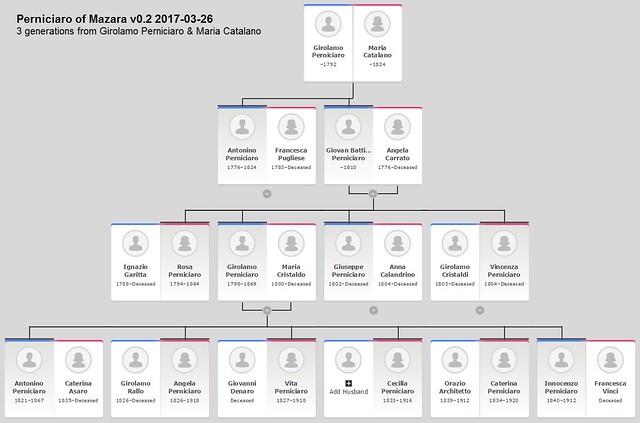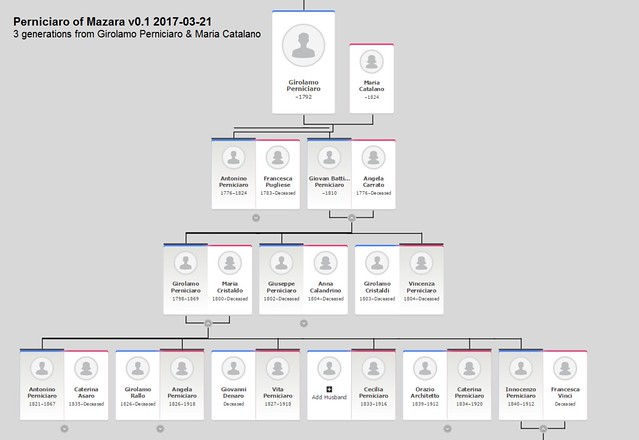The founder of the family was Giuseppe De Santi (1847-1923), son of unknown parents. Giuseppe married Maria Tumbiolo (1853-1926), the daughter of Alberto Tumbiolo and Maria Quinci.
Giuseppe and Maria had at least 7 male children:
- Francesco (born in 1874), married with Caterina Giacalone;
- Alberto (born in 1880), married with Francesca Asaro (born in 1891);
- Vincenzo (born in 1881);
- Antonino (born in 1884), married with Marianna Quinci (born in 1892);
- Pietro (born in 1887), married with Rosa Adamo (1896-1919);
- Bartolomeo (1890-1964), married with Vita Palmeri (1899-1978);
- Leonardo (1892-1969), married with Giovanna Adamo (1898-1974).
The surname of the De Santi family in the older records is often found written with the De followed by an apostrophe, as in "De 'Santi". That truncation over the years has led several late XIX century clerks of the Mazara registrar office to understand the surname of the family as "Dei Santi", an interpretation the family fiercely opposed, as they kept requesting the tribunal to get the family name amended as "De Santi" in the records. Ironically, in the birth record of the founder, who was exposed to the wheel of the "Spedale dei Projetti" of Mazara on November 1, 1847, the then mayor Pietro Safina wrote "Giuseppe dei Santi" (here you may find page 1 and page 2 of the record).
The "nciuria", the family nickname, was apparently "Diana" or "La Diana". One of Giuseppe's 7 sons, Bartolomeo, often shortened in Bartolo, in 1928 had a Monterey clipper built in San Francisco, California, and named it "La Diana". Bartolo's son, Joe De Santi, a fisherman as well, bought the fishing ship by his father for $5 in 1939, and he used it to fish in the waters in front of San Diego until 2001, when he finally retired, and donated the boat to the Maritime Museum of San Diego, which restored it and kept it dry on a pier (here a recent photo gallery).
All the 7 male children of Giuseppe and Maria emigrated to the States, but 4 came back, so the descendants are mainly distributed between Mazara del Vallo, Sicily and San Diego, California.
The result of the research have been stored in FamilySearch and copied in Geni. The FamilySearch profile of the founder Giuseppe De Santi is https://www.familysearch.org/tree/person/LT5G-F19.
Post scriptum:
in the XIX century Mazara there was a different "Dei Santi" family, whose founder was Santo Dei Santi, born around 1831 by unknown parents. Santo married Susanna Rallo (born in 1841), of the Rallo family of butchers, and like many descendants of that family, also the namesake nephew Santo Dei Santi (1894-1985), son of Giovan Battista Dei Santi and Elisabetta Mulone and husband of Girolama Giacalone, emigrated to Saint Louis, Missouri, where his descendants still live.



